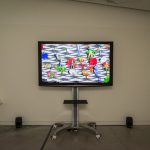“Panopticon I” by Gregory Bennett
Title:
- Panopticon I
Artist(s) and People Involved:
- Gregory Bennett
-
- Auckland University of Technology
Exhibiting Artist(s):
Symposium:
Venue(s):
Creation Year:
- 2015
Medium:
- Single-channel video
Size:
- 14’33’’
Artist Statement:
Panopticon I (2015) is a continuation of an ongoing series of digital still and moving image works which feature groups of digitally generated and animated groups of figures engaged in often complex activities, frequently in relationship to specifically created digital environments. These works create views of intricate digital colonies from elements which are produced in a professional 3D animation software program. Here an endlessly rotating point-of-view of a circular panoptic structure is presented, exploring conceptions of the utopian and dystopian, constructs of order and control, and the spaces between human and technological agency. The panoptic construction is populated by an ever-expanding taxonomy of animated figures, plants, objects, and architecture which interact, assemble and re-assemble, simultaneously fixed and unstable, trapped in ceaseless loops and cycles in a form of animated stasis.
The Panopticon was an institutional design concept created by 18th century English philosopher Jeremy Bentham, wherein a single watcher is able to observe all the inmates of an institution simultaneously. Inmate knowledge of this surveillance would be an effective means of self-monitored behavior control. Originally considered a progressive and enlightened solution to societal problems, the Panopticon has come to be read as a central metaphor for modern “disciplinary” societies and their pervasive inclination to observe and normalize, most notably by French philosopher Michel Foucault in his work Discipline and Punish (1975).
A generic animated figure is employed as a building block in this creation. The replicated figure is assembled and reassembled into units of performed actions, loops and cycles, creating ongoing series of patterns of movement vocabulary. These bodies’ movements are brought to a form of uncanny life using two methods, activated either by hand using key frame animation, or by the use of digital motion capture whereby a live performer’s bodily motion is recorded as 3D movement data, and then applied to a digital character’s skeleton. The combination of fluid captured motion with the generic digital form can lend an eerie ‘liveness’ to the figures, creating ambiguity around their status as performers with inherent agency.
Natural elements such as plants are animated using dynamic simulation tools whereby natural phenomena such as wind, gravity, bounce and friction are generated algorithmically, and can be customized by altering numerical values via software interface controls, replicating a convincing realism in natural movement which is extremely challenging and time-consuming via traditional key frame methods.
The corporeal body is transformed into proliferating avatars whose resistance to the panoptic structure seems negligible – they exhibit a range of responses from resignation, to ecstatic ritual, to enacting seemingly mindless and/or compulsive repetitive actions, and small acts of resistance to this order seem futile. Here structuring principles of cycles, loops and modularity can be seen as resisting ideals of linear progression, and time and space become ambiguous factors here – the environment rotates past the viewer situated in a kind of metaphysical ‘no-space’ reminiscent of a video game environment.
Tethered to the endless cycle of looped actions these figures resist the conventions of linear narrative progression, trapped in a kind of compulsive stasis with no clear beginning or end. They also form discreet units of action, which can be arranged and rearranged at will in the creation and construction of the work. The loop forms the most elementary form of the structures of programming language, which involves the altering of the linear flow of data structures through control structures such as the loop. Lev Manovich champions the loop as ‘a source of new possibilities for new media’, and conceptualises it as an ‘engine’ which puts narrative in motion. Loops retrieved from the ‘database’ are a ‘multitude of separate but co-existing temporalities’ – units which do not so much replace each other in a ordered flow, but are rather are already-activated elements which are composed in one of any possible sequential chains. This condition of the loop and its apparent inability to achieve resolution, or perhaps the illusion that it creates of some kind of perpetuality, recalls animator Robert Breer’s comments on metamorphic transformation:
“…time doesn’t move forward, things are going, but sideways, obliquely, down and backwards, not necessarily ahead. The sense of motion is the issue. That idea seems hard to defend, because our locomotion drives us forward with our faces looking at new things. But since that movement is toward oblivion, in my philosophy anyhow, it might as well be backward. It’s a delusion to think you are getting anywhere.”
Drawing on and remediating a range of sources including the photographic studies of Eadweard J. Muybridge, nineteenth century optical toys, and the contemporary digital video game, this work presents figures which occupy a space between the animate and the inanimate, between automata (devices that move by themselves) and simulacra (devices that simulate other things).
Another touchstone is the elaborate geometric ‘choreography’ of 1930’s Hollywood musical director Busby Berkeley which featured armies of women whose individualism is also radically reduced – as though all cast from the same mold. Here ‘their identities are completely consumed in the creation of an overall abstract design’. It is not so much choreography on display, as Lucy Fischer describes, but ‘kinetic designs’ and ‘mechanical decor’, they are ‘elaborate pre-programmed machines for action’ and ‘repetitive movement’. The association with the rhythms of mechanical movement seem always present when discussing Berkeley: Theweleit observes “the legs and hands of the line-series are not saying anything, rather they are performing something: the modus operandi of cogs, mechanical links, belt transmissions…”. They are “ornaments of the technical performed”: machinic, subject, malleable, compulsively aping technical processes. In the creation and execution of this work a hybrid space is explored where human and natural agency are uncertain: phenomena of nature are simulated algorithmically, human activity is seems essentially passive and annulled, where gesture does not follow thought or emotion, but instead is generated zombie-like by another’s will.
Website:
Video:
Category:
All Works by the Artist(s) in This Archive:
- Gregory Bennett
- More Art Events from Gregory Bennett in this archive:

Panopticon I
[ ISEA2016]
Visions and Fantasies
[ ISEA2012]




